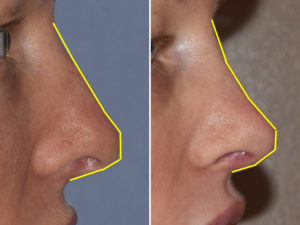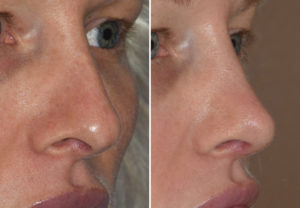Background: Feminization of the nose typically implies certain featural changes. Amongst them includes a a narrow nose in the front view and a lower dorsal line with upward tip rotation in the profile view. The degree of these changes is what influences the degree of nasal feminization and the patient’s perception of them.
The reduction of an osteocartilaginous nasal hump is of the most common nose reshaping requests. And while removing such a hump is common in many female rhinoplasties, the achievement of a straight dorsal line in profile may not be adequate for some patients. While a straight dorsal line is the standard goal for many rhinoplasties, for some females this may not be enough. Rather they prefer a more concave dorsal profile or a ‘swoop’ from the top of the nose down to the top where it re-emerges.
The appearance of the tip of the nose in profile is partially defined by its nasolabial angle. While in men a 90 to 95 degree nasolabial angle is optimal, a more open nasolabial angle of 95 to 105 degrees in women is more desired. For women seeking a highly rotated tip a nasolabial angle of 110 to 115 degrees may be needed. But the nasolabial angle is not the only way to assess the nasal tip in profile. The shape of the supra tip area at the superior end of the columella also influences how much the tip appears rotated.
Case Study: This female had a history of a prior closed rhinoplasty which provide her improvement but left her wanting further changes. She felt the first rhinoplasty was too conservative.


Case Highlights:
1) Secondary rhinoplasty to reshape to optimize the feminine shape of the nose revolves around lowering the dorsal line and increasing nasal tip rotation.
2) For the most assured result an open approach is usually best in secondary rhinoplasty.
3) Lowering the nasal dorsum and creating further tip rotation runs the risk of alar rim retraction which can be avoided by alar rim cartilage grafts.
Dr. Barry Eppley
Indianapolis, Indiana




